Early
History of Single Lens Reflex (SLR) camera
(c) Frank Mechelhoff 2005 - Kopien speichern nur zum
privaten Gebrauch zulässig
Texts and pictures are copyright protected
Kontakt: taunusreiter "at" yahoo.de
Read this Page
in German language 
update
26. November 2009
 Picture of Pentax Switzerland
Picture of Pentax Switzerland
1954 Asahiflex-IIB
Asahi Optical Company launched the first SLR with Instant Return
Mirror. Just imagine: Before this camera, when pressing the trigger
of an SLR, the finder became (and kept) black! So arguments can
be made that this camera was the first usable SLR -
beforehand it only was a niche market for EXAKTA in Dresden and other
firms like Pentacon mostly in the East part of Germany (GDR) - but not
accepted by ambitious 35mm photographs who preferred Rangefinder (RF)
cameras from LEICA, CONTAX and their Japanese copyists in the early
1950's...
Whereas Nikon, Canon, Minolta and Fuji started Camera business with
RF-Cameras before - after the success of PENTAX -
they turned to SLR design, PENTAX really started with SLR (first
camera: Asahiflex I of 1952) and never produced a RF design.
What kind if cameras
are that ?
After World-War-II these Single Lens Reflex cameras- SLR -
were smiled by estabilshed photographs because they are quite ugly,
odd, heavy and slowly.compared to fast LEICA or CONTAX with their
elegant rangefinders. Phtographyic industry speaks German and most, if
not all SLRs come from the communistic part of Germany, GDR. Well, what
qualirty is to expect from commustic countries? And Japan? No own
ideas, just copyists... no copy can be better than the origin... this
talk from toffee-nosed experts and sales people went again and again
for more than twom decades... until 1970 the West German camera idustry
was went to
hell in a handbasket.
At 1950 the critics about the SLR are not alsolutely wrong... Look ar
these diminutive focussing screen - hip-shooting you need excellent
eyes to focus these small screens - even with a Rolleiflex 6x6 this
isn't so easy and it has 4x its film format.. either it is too bright
or too dark and you see nothing.
SLR's are better with long focus length lenses - maybe true, but, dear,
who in the world has lenses with more than 135mm ? Just a handfull of
photographs. Press Photgraphs,i.p. Americans, take these 35mm cameras
as toys - in a crowd you need a big camera for getting respect and room
to work. So they take these bulky Graflexes. This will change in
the late 1960's after war stories from photgraphs in Vietnam taking a
rescued from a bullet by their NIKON camera... this happend not too
often... In
the 70's and 80's professional cameras are equal to SLR in peoples's
believe. Rangefinder sales went near to zero because no one thinks you
can make
usefull photos with any other stuff than SLR - industry makes cameras
who
only looks like it... A few landscape and promotional photographs keep
the 6x6 or Large Format solely. Even todays digital professional tools
form CANON or NKON are looking like Film-SLRs even there is no need for
that look any longer.. this is a great success story!
 1936
- Ihagee = inventor of 35mm SLR
1936
- Ihagee = inventor of 35mm SLR
1936 - Leni Riefenstahl is filming Olympia
in Berlin for Adolf Hitler, wherefor ZEISS develops a high speed f/2.8 180mm Sonnar-lens. Not far
away from the capital, in Dresden the company Ihagee
brings the worlds first SLR camera for für 35mm cinema film to the
market, the Kine-Exakta. A modern camera with horizontal
focal plane shutter from 12 to 1/1000s. 1940 the company of the Dutch
owner is breakuped, civil production is cancelled - camera production
is war-important! Another Ihagee invention: The fast film advance lever!
Prior to this, Ihagee also made the
first SLR (Exakta-A) for small roll film (127-format which was 6,5x4cm)
in 1933.
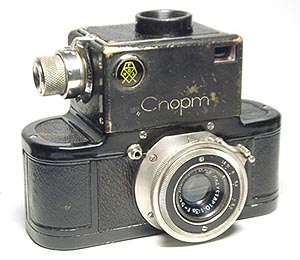 1937 - GOMZ Sport
1937 - GOMZ Sport
It was said that Russian GOMZ Sport was the first 35mm film SLR
prototype (1935) but it takes them as late as 1937 to bring it to
market and lacks the impression and a good lens series.
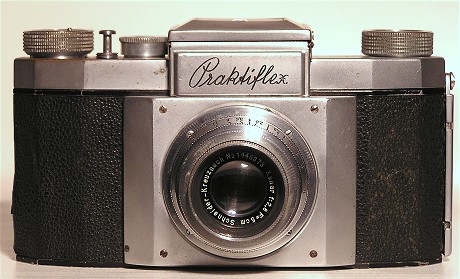 1939 - Praktiflex
1939 - Praktiflex
You think the Asahiflex IIB was the first SLR with a mirror
that returns after firing? Wrong. Camera factory
Dreden-Niedersedlitz (after the war VEB Pentacon) build them 15
years before Asahi Optical Co, making nearly 60.000 of them, from 1941
on with a 1/1000s. The last big run, a simpler version missing the
return-mirror (1946-1948) is for Russian war reparations. Like the
Exakta, a somewhat bulky camera. lens adaption with M40 screw mount,
abnd probably at last M42. There was no interlock
between the whole mirror way upwards and downwards - just a connection
when
pressing the trigger the mirror was lifted, and came back down when
finger lifted the trigger. This was a simpler mechanical solution than
later instant-return-mirror who were triggered by mechanical force and
worked better with faster shutters. Unfortunatly, their
successors Praktika and Praktika-FX lacks this
feature, nor enhance it like Asahi-Optical did, and so it was
quite oblivious...
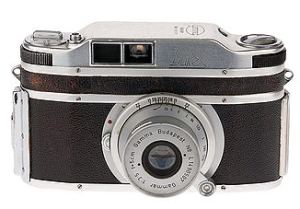 1947 - Gamma Duflex
1947 - Gamma Duflex
The first SLR with return mirror, automatic diaphragm plus upright
eyelevel finder (with a series of mirrors instead of a prism). Quite a
good design, even the camera looks a bit large. Double finder (the
reflex finder is just for focussing). Just 800 pieces were produced
before the factory was closed. Almost unknown, just a footnote in
photographical history...
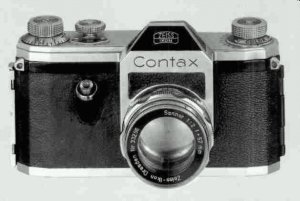 1949 - Contax S
1949 - Contax S
Around 1940 at Zeiss-Ikon nearby in Dresden, maker of the
famous CONTAX Rangefinder cameras, which
together with their lenses many
photographs
oft the time take for better than the prewar-LEICA, the attitude is
more
innovative than it is at the competition in Wetzlar. A CONTAX-SLR is
developed, to be called SYNTAX. The war stopped everything. After the
firestorm Zeiss-Ikon is in debris. The company is diveded as the whole
nation. Zeiss-Ikon Dresden is restructered as public owned enterprise
(VEB, Volkseigener Betrieb) and after backup to procution, the
idea is resumed. Result is the Contax
S, with the Rectaflex first SLR with a viewer prism. The world isn't
side-inverted for the SLR-photograph any longer...
The first camera with M42 screw mount together with the Praktika
Build in numbers of 26.000, the Contax S isn't as successfull as they
merrit to. But it was the most expensive 35mm camera at their time, 50%
more than the best Leica (475 USD in 1950)
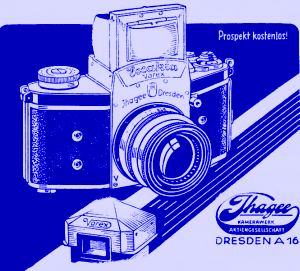 1951 - Ihagee Exakta Varex
1951 - Ihagee Exakta Varex
Ihagee, now VEB as well, match up: The camera is available with prism
or chute finder - first changable finder system at an SLR !
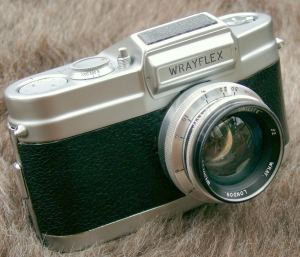 1951
Wrayflex (England)
1951
Wrayflex (England)
Made by WRAY Optical Works in Kent, there was a nice, comfortable to
use, excellently made SLR with a fast cloth curtain shutter - sadly
without a prism but with three mirrors which results in an upright,
side reversed (and not very bright) finder image. And with just 5
lenses available to the camera. In a run of 10 years 3.000 pieces were
build. She kept to be exotic..
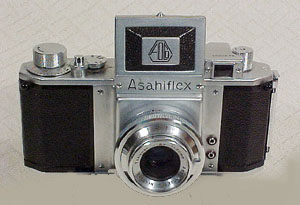 1952 - First Asahiflex
1952 - First Asahiflex
Different from NIKON, CANON, YASHICA and other Japanses companies
who started with Rangefinder cameras, building LEICA or CONTAX prewar
camera copies, Asahi Optical is convinced to SLR right
from
the beginning.
Except from compact size which reminds to a screwmount-LEICA there is
nothing special with the first "Pentax". Not a prism yet. shutter speed
to 1/500s only.
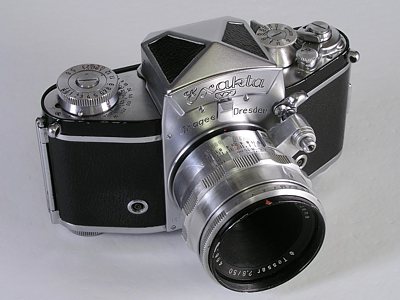 1954 - Press Aperture at lens
1954 - Press Aperture at lens
One disadvantage for fast shooting compared to
RF cameras, you need to focus at full aperture and after this stop-down
for shooting. For the leafshutter-SLR ZEISS-IKON Contarex (no changable
lenses) the fist automatic diaphragm is shown 1953. Poor Contarex will
never
be equipped with an instant-return-mirror until ceaing production in
1970.
For changable lenses and with focal plane shutter, one year later
Exakta solves showa attachments for lenses upstream to the trigger
which stopdown
immediately when pressed. At this camera all controls are side-inverted
to "Leica-standard": A good choice for lefthanders. But this
attachments
are not common for every lens, makes trigger slow and lens-mount more
complicated.
Not fully satisfying...
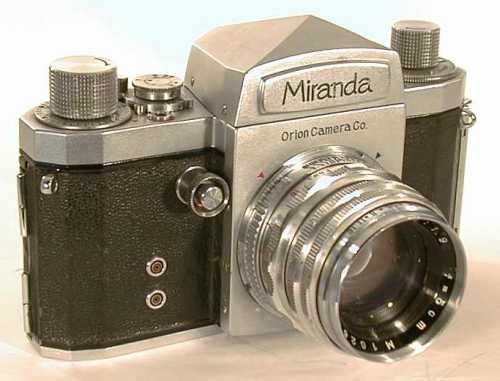 1955 - Miranda
T (Orion
T)
1955 - Miranda
T (Orion
T)
The first Japanese Pentaprism SLR - changable like Exakta Varex, but
more compact and sleek lined design. Missing: lever advance, instant
return mirror....
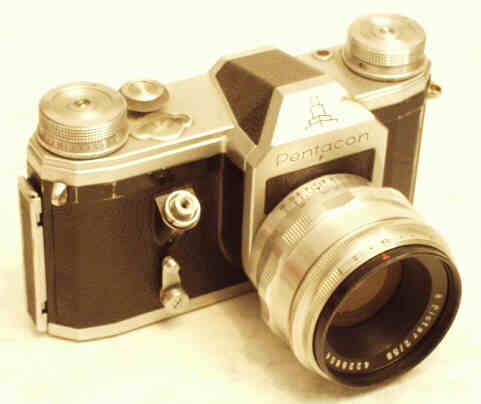 1956 - Pentacon F/ Contax F
1956 - Pentacon F/ Contax F
This is the first camera with innert aperture triggering - transmission
within the lens mount lens mount - first "real" autmatic diaphragm -
the right approach!
Successor of the Contax S, but missing the instant return mirror
and fast lever film advance - invented 15 years earlier in the same
city
this camera was produced.. don't change too much stuff ! This is the
last innovation of GDR made cameras for 13 years..!
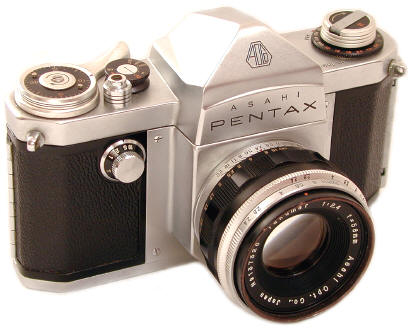 1957 - The original Asahi-Pentax
1957 - The original Asahi-Pentax
Not a revolution technically, the "original" Asahi Pentax (later called
AP by collectors) this camera at first combines these new features in
one and therefore, is the best buy at their time:
- Pentaprism
- Instant return mirror
- Film fast lever advance and
rewind crank
- M42 screw mount (lenses named "Takumar")
All this combined with a adorable clear, modern
design which sets standards for this genre for 30 years! In addition,
it is compact and lightweight - just 580g compared to the usual
800-900g Not cheaply made - you can feel it. Half a century later, they
are working as good (or sometimes, as bad) as the German competitors of
the same vintage...
PENTAX isn't too proud to mit their logo for trading marks like Tower,
Heiland, Honeywell etc. to gain sales share in USA or other markets.
They yield sales effort to those who know the market better than they
do in the late 50's, early 60's. Later than, if ciustomers remember to
a good product they will buy it under tehir real name.
It is also a good idea to copy the M42 screw mount of
East-German Pentacon - later called Pentax scremount by many -
even if it is clear to that time that any screw mount lens adapting
isn't the best idea technically.
But Pentax first target is selling cameras - Carl Zeiss Jena
and other East German optical companies doing some of the best lenses
of the world at that time, and you can use it! Next Pentax started to
develop their own lens series, and they do it different than East
German optical industry: More compact, more speed, better finished,
modern looking - and from optical quality (something which isn't seen
outright) at least equal.
1958 - Pentax K
second stroke of Pentax:
- semi-automatic diaphragm mechanism through
the lens mount with a pin to the lens (called "Auto-Takumar" -
buit you can use every manual lens as well)
- shutter with 1/1000s now,
but stil with rotating dial and second low speed dial
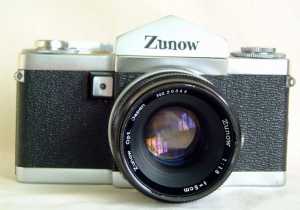 1958 - ZUNOW
is a small, fine Japanese factoy making cameras and lenses in low
numbers. Building the second Japanese SLR with Instant return mirror
and automatic diaphragm called Zunow-matic Diaphragm System - and
bayonet lens mount. Starting in August 8 pieces a day...
1958 - ZUNOW
is a small, fine Japanese factoy making cameras and lenses in low
numbers. Building the second Japanese SLR with Instant return mirror
and automatic diaphragm called Zunow-matic Diaphragm System - and
bayonet lens mount. Starting in August 8 pieces a day...
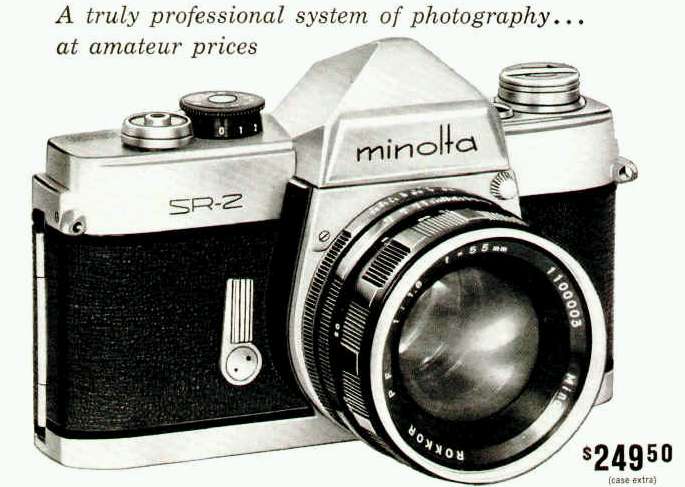 1958 - Minolta
SR-2
1958 - Minolta
SR-2
If you ever own a Minolta, will you recognize it as a Minolta? For
sure. You would think this one is nearly 50 years old? Never...
In business as a maker of (quite well made) LEICA screwmount copies,
this is Minoltas first SLR... and a great one! This design will last
the next 25 years as well!
First Japanese SLR with non-rotating single speed dial (you can buy it
at a LEICA M3 since four years now), third Japanese camera-maker with
instant return mirror and semi-automatic diaphragm, rewind crank, fast
lever advance - plus a modern bayonet lens mount, without breech lock -
basically the same which Minolta still use today, so it's only 4 years
younger than LEICA M which is also still in use.
The first SLR with motor-drive connector - unfortunately Minolta
never decided to produce one...
First company with dual-coated lenses (called multi-coated but that was not the case)
So with all these great features, why it hadn't the same success
than Pentax and Nikon? Probably because of the proprietary lens mount
and small lens family. So it keeps as a typical amateur camera till
present
- but other than ZUNOW and MIRANDA has a luck to survive.
This was a great year for Japanses camera designers, probably the best
ever. Unmortal designs like the CANON-P,
NIKON SP or
NIKON-F
were created.. no, the copy-era was gone, forever. Japan took the lead.
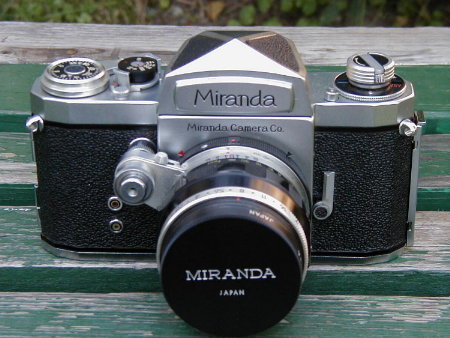 1958 - Miranda
1958 - Miranda
Just know Miranda as a girl from "Sex& the city" ?-
No matter, the company is gone for quite 30 years. But in the 50's they
made nice modern cameras. In 1958 they had no instant return mirror yet
- a real drawback - but was catched up one year later with the Miranda C
(picture). Similar to Exakta Varex are Press diaphragm and changable
prisms. Bajonet mount. In the early 60's the same selling success as
Pentax.
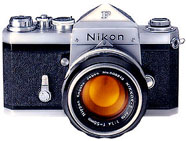 1959 - NIKON F
1959 - NIKON F
in the same year the NIKON F took off.. which became the
first professional SLR of the world for more than a decade.
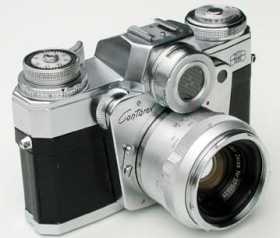 1959 - Zeiss-Ikon Contarex
1959 - Zeiss-Ikon Contarex
The West-German answer to the Japanese focal plane shutter cameras is
the CONTAREX
- 1958 showed at Photokina - excellently finished, but hevyweight (910g
without lens) and far too expensive and complicated. Even at its high
price - 1030 DM in 1964 (it was doubt that even this price was
cost-effective) and
huge accessory program it was not first choice for professional
photographs.
Ugly selenium meter (bulls-eye) coupled both to shutter speed and
aperture
dial (which is part of the camera, not the lens). 32.000
produced
until 1966. One segment lower there was the CONTAFLEX: a leaf shutter
camera
with a small series of exchangable lenses (slow, due to the size
requirements
of shutter). More success than the Contarex - but not enough either to
keep
them survive...
back to main Pentax page
To NIKON page

 Picture of Pentax Switzerland
Picture of Pentax Switzerland 1936
- Ihagee = inventor of 35mm SLR
1936
- Ihagee = inventor of 35mm SLR 1937 - GOMZ Sport
1937 - GOMZ Sport 1939 - Praktiflex
1939 - Praktiflex  1947 - Gamma Duflex
1947 - Gamma Duflex 1949 - Contax S
1949 - Contax S 1951 - Ihagee Exakta Varex
1951 - Ihagee Exakta Varex 1951
Wrayflex (England)
1951
Wrayflex (England) 1952 - First Asahiflex
1952 - First Asahiflex  1954 - Press Aperture at lens
1954 - Press Aperture at lens 1955 - Miranda
T (Orion
T)
1955 - Miranda
T (Orion
T) 1956 - Pentacon F/ Contax F
1956 - Pentacon F/ Contax F 1957 - The original Asahi-Pentax
1957 - The original Asahi-Pentax
 1958 - ZUNOW
is a small, fine Japanese factoy making cameras and lenses in low
numbers. Building the second Japanese SLR with Instant return mirror
and automatic diaphragm called Zunow-matic Diaphragm System - and
bayonet lens mount. Starting in August 8 pieces a day...
1958 - ZUNOW
is a small, fine Japanese factoy making cameras and lenses in low
numbers. Building the second Japanese SLR with Instant return mirror
and automatic diaphragm called Zunow-matic Diaphragm System - and
bayonet lens mount. Starting in August 8 pieces a day... 1958 - Minolta
SR-2
1958 - Minolta
SR-2  1958 - Miranda
1958 - Miranda 1959 - NIKON F
1959 - NIKON F  1959 - Zeiss-Ikon Contarex
1959 - Zeiss-Ikon Contarex